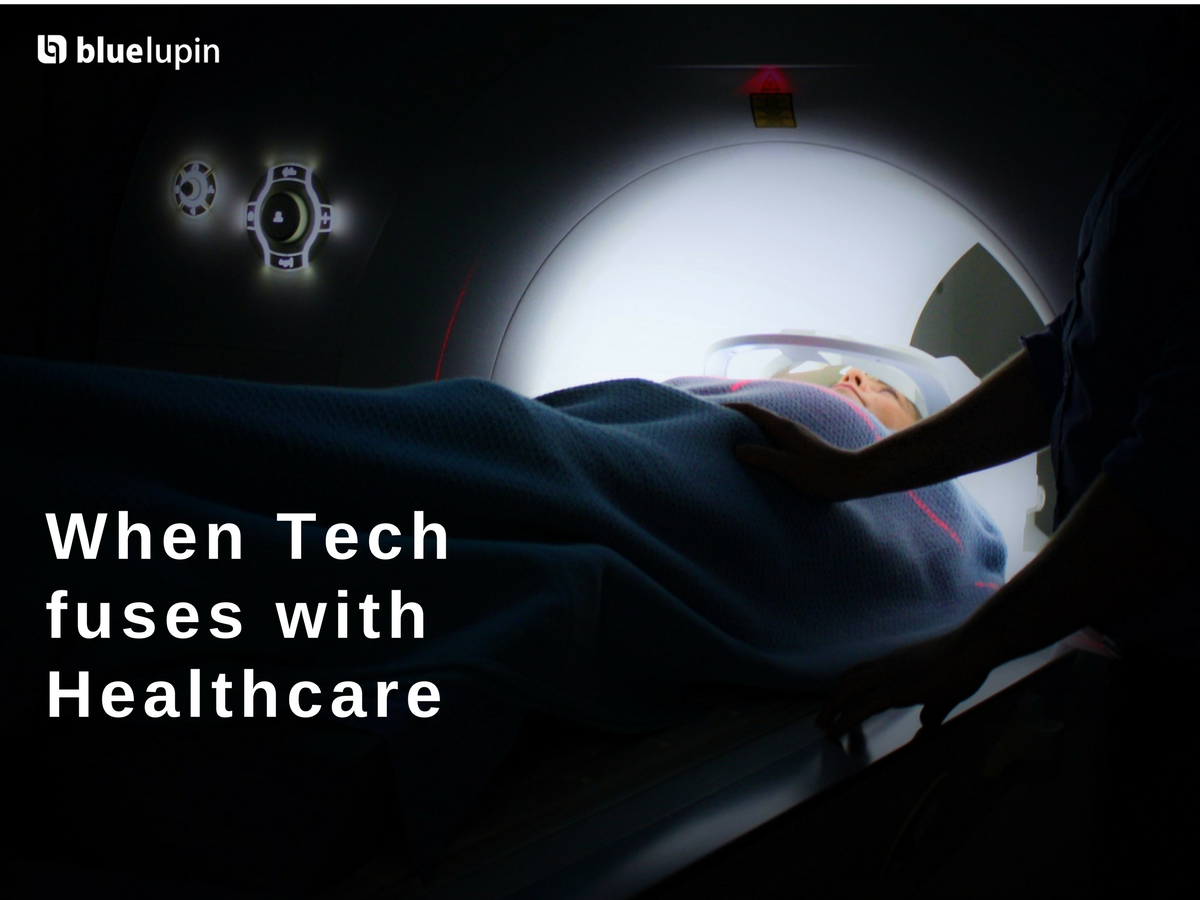When Technology fuses with Healthcare: Ameliorates healthcare standards

Ever imagined?? How has health issues motivated technology to develop at this faster rate? Well, Healthcare has always been the greatest concern of humankind. This great fusion emanates great skepticism. As it is always advised to keep your electronic gadgets and devices away from you for a better health then how can technology integrate with healthcare management to provide better facilities in improving health? If I were to add more trepidation to this, I would question that are you scared that Robots will take over the jobs of nurses, doctors and other healthcare professionals. Another skepticism could be that are you petrified to face a genetic test that would disclose the day of your death?
Another skepticism could be that are you petrified to face a genetic test that would disclose the day of your death?
To answer to this in a nutshell, I will say that these are all vague notions, half-truths or imaginary dystopias. Technology has played a major role in shaping up health care through artificial intelligence, VR/AR, 3D printing, Robotics and nanotechnology. To get an insight of this fusion let us see what contributions these technologies have made since the time they are discovered.
NANOTECHNOLOGY
Nanotechnology has been a revolutionary step in almost every sector but its application in medical science will be prodigious. In nanotechnology, we deal with subjects on Nano scale. For example, if we put Nano molecules adjacent to each other, it will still take almost 5000 particles to circumscribe a human hair. This way we will be able to inject any medication or treatment whenever required directly on the infected part thereby treating the disease in an effective manner. It has also been said that Nano-technology can allow the medicine to be efficient by more than 99%, which is way better than what is achieved through pills or other methods.
NANOTECHNOLOGY IN CANCER TREATMENT
The national institute of health (NIH) said that with Nano-bots, medical industry can be revolutionized by being able to do things like mechanical removal of plaque from arteries, tissue preparation for cryonic storage and many more. But the most speculated outcome is in cancer treatment. Considering the present scenario, cancer treatments are not so affordable by a major chunk of population and also less effective in curing the disease. Cancer is often diagnosed at advanced stages because of lack of information regarding its symptoms leading to higher mortality rate in India.
Thus, Nanotechnology will allow for a highly effective cancer treatment acting directly on the cancer tumor and eradicating it completely without affecting the healthy cell much at all. This direct functioning might even allow for treatment of cancer with less side effects and highly effective treatment even at higher stages of cancer.
Similarly, Nanotechnology can be applied to almost all the medication practices. And if possible, it can also be used to monitor body to caution a person of a disease even before the onset. Even a patient who is undergoing a treatment can be monitored of any unusual activity in his/her body which might affect the person’s healing, even remotely!
Thus it is being highly anticipated that all this can become a reality soon, making life better and treatments becoming more affordable, effective and efficient.
ARTIFICIAL INTELLIGENCE: A LOT MORE THAN DISCOVERED

Artificial Intelligence (AI) in itself is very humongous and there is a lot of buzz around AI these days. It is so widely spread across multiple disciplines like physical, digital and biological fields such that its applications are considered to be beneficial in healthcare too. To better understand this term we need to understand the authentic definition of AI and hence need to dive into the times when it was originally coined. The official definition of AI was first explained in speech or writing by John McCarthy in 1955 at the Dartmouth Conference. The definition proposed by McCarthy is “Every aspect of learning or any other feature of intelligence can in principle be so precisely described that a machine can be made to simulate it. An attempt will be made to find how to make machines use language, form abstractions and concepts, solve kinds of problems now reserved for humans, and improve themselves.” A simpler translation of this is that Artificial Intelligence is, in contrast to natural intelligence, undoubtedly exhibited by machines and is presumed to be good at accomplishing complex goals.
HOW ARTIFICIAL INTELLEGENCE IS DIFFERENT FROM HUMAN INTELLIGENCE?
The uphill struggle of Artificial Intelligence is the research to build machines that would be as broad as human intelligence which can do anything and once that happens it is not likely going to be as good as human intelligence but a lot better than human intelligence.
Human intelligence which will always remain superior to machine intelligence has bestowed many super powers to machines through Artificial Intelligence. It is an incredibly valuable technology which enables machines to behave like humans or sometimes even better than humans thereby dreading to even replace several human jobs in the upcoming years. Earlier machine intelligence was always inferior than human intelligence but gradually machine intelligence got better than human intelligence in very narrow areas like multiplying numbers fast, pocket calculators, remembering large amount of data and operating in very less time. Machine intelligence is spreading out from those narrow peaks and getting a bit broader. The uphill struggle of Artificial Intelligence is the research to build machines that would be as broad as human intelligence which can do anything and once that happens it is not likely going to be as good as human intelligence but a lot better than human intelligence.
INTEGRATING AI IN HEALTHCARE
The cognition of integrating AI with healthcare turned out to be miraculously amazing. Seeing into the future of healthcare, a system currently stretched to breaking point failing to meet certain guidelines to save the site of hundreds of people every day. But perhaps, the solution lies not with more doctors but with machines powered by AI. The potential is enormous. For DNA test, AI could mean better care at lower cost as machines can take over some of the jobs done by doctors. Their powers come from not just analyzing image in just milliseconds but learning from the data they collect.
REDUCING MOTALITY RATE:
AI allows computers to perform not just repetitive tasks, but it also gives them the ability to reason, think, learn and even understand human emotions. In the field of medical science, AI aids doctors in their objective of reducing the mortality rate among patients awaiting care from specialists.
REDUCING ERRORS ASSOCIATED TO HUMAN FATIGUE
The ratio of doctors to population in India is 1:1800 which clearly reflects the amount of mere attention a patient must be receiving. This indicates that the whole process of examining each patient must be very tiresome. This is where AI takes the lead. Unlike human doctors, AI is unfazed by numbers of patients, long work hours and task redundancy. In this regard, AI works as a super human spell checker, assisting doctors by eliminating human errors and relieving them of time consuming monotonous task.
DECREASE IN MEDICAL COST
AI assistant/ programs reduce medical costs by eliminating office visits with online care. Patients would be requested to submit data frequently by online medical records and the enhanced line of communication could result in less office visits. Cost reduction could also be achieved from efficient AI diagnosing and screening of high risk patients.
REAL TIME DETERMINATION OF DISEASE ON THE BASIS OF SYMPTOMS
Currently there are certain mobile based apps (for ex: Ada) which are able to detect possible cause of the symptom or discomfort in the body based on the information provided. Although they have a long way to go but they are still pretty much helpful in giving the idea of the possible disease one might be suffering from.
3D- PRINTING
What is 3D printing?
It is the action or process of making a physical object from a 3D digital model, layer by layer. 3D printing has been a highly proficient invention, since it is being used in almost all walks of life these days. The scope of 3D printing is so vast that it is difficult to pile it up in this single section.
IMPLEMENTATION IN ENGINEERING
As regards with engineering, 3D printers are used to develop models to study various complex components or equipment before manufacturing, thus eradicating material wastage and production and planning cost. 3D printing is being applied to food manufacturing to eradicate global hunger and food shortage. Similarly, many other applications of 3D printing are possible which earlier were either very complicated or time taking.
FUSION WITH HEALTHCARE:
- Amongst all its applications in various fields, healthcare turns out to be one of its best areas in practice. In the medical field, treatment often gets difficult due to the complexity of the human body, scarcity of donors, complexity of disease and many other reasons. But with 3D printing technology, humans are racing towards an era where getting a matching donor might no longer be required, surgeries might not remain as complex as they are today, prosthetic limbs or body parts get more affordable and approachable.
- According to the stats, 96% of the hearing aids are already being manufactured through the use of 3D printing technology. Other than this, dentistry is another field where 3D printing technology is doing wonders. Since dental science requires patient specific implants, therefore 3D printing was the answer to the conventional and expensive methods. The person needing implant is scanned for the required implant with their specific measurements and preferences. This is a great step in personal healthcare.
- Not very long ago, prosthetic limbs were cumbersome and very expensive for the mass, but with 3D printing technology they are becoming affordable and customer centric. Imagine a child in a need of prosthetic arm, the child will soon outgrow the arm and will continue this till his adulthood, which can be a very difficult situation as a child and parent. But 3D printing technology makes this affordable, thus people can afford this expense.
FUTURE PROSPECTS OF 3D-PRINTING TECHNOLOGY
These were only some extracts of what all is happening around us. But what about the future scope? With the on-going experiments, soon we will have bio-printing which could print organs using cells from the patients and growing them in separate facilities. This, in turn, will eradicate the need for matching organ donors. As depicted in many Hollywood movies, Cell regeneration can soon be a possibility with Bio-printing, healing burns, body muscle loss, or any major or minor cuts and wounds within minutes.
As depicted in many Hollywood movies, Cell regeneration can soon be a possibility with Bio-printing, healing burns, body muscle loss, or any major or minor cuts and wounds within minutes.
With 3D printing, doctors can even practice a complex surgery before actually performing it on the patient. Or could know what an actual deformity or problem is by getting a feel of it instead of visual observation and imagination. This can be phenomenal step as the exact treatment could be advocated, drastically reducing the surgery time and saving life more effectively.
Hope this was helpful. Do not hesitate to write to us if you know any more amazing information or facts regarding this great tech fusion in healthcare.
